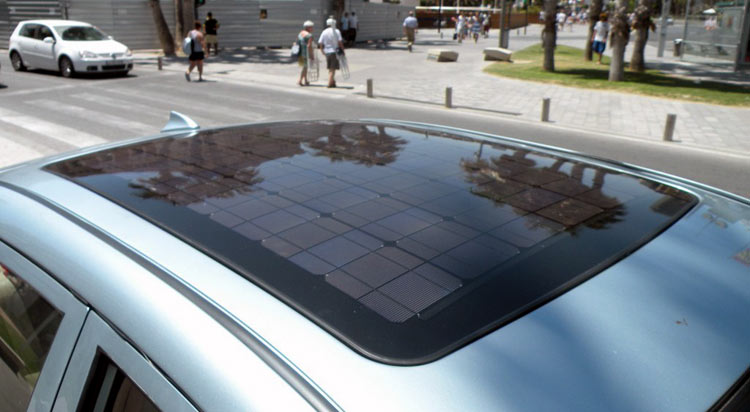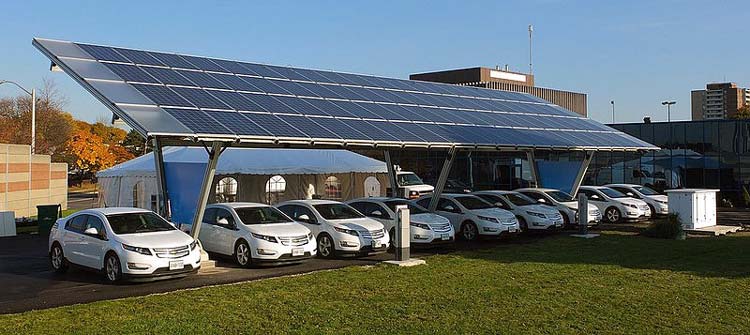
Transportation accounts for around 30% of our carbon dioxide emissions in the atmosphere globally. The number of fossil fuel cars is set to double by 2040. Various automobile companies have been working on electric vehicles but these vehicles have some dependency on fossil fuels. What then could be the smart solution to cut down the percentage of carbon dioxide emissions from the vehicles?
Solar-powered cars, maybe! From boosting the cash flow to becoming independent of ever-increasing gas prices, adopting a solar electric lifestyle definitely makes sense. MIT physics professor, Washington Taylor states that solar energy has enormous potential. A total of 173,000 terawatts (trillions of watts) of solar energy strikes the Earth continuously. That's more than 10,000 times the world's total energy use. And that energy is completely renewable at least for the lifetime of the sun.
There many different electric vehicle manufacturers that are tackling climate change smartly. Talking about solar-powered cars, there’s a lot of buzz around. However, no automaker till date has commercially launched a solar car for the market. Even though we have known solar power for a decade which is one of the main sources of energy available almost everywhere, we humans yet haven’t been able to explore many possibilities of using the same for commuting. Not that the idea hasn’t popped up in anybody’s mind.
For years, the concept of the solar-powered car has made environmentalists hopeful of the possible future. But there are many arguments to this concept as it is considered not only impractical but kind of impossible. Many prototypes of solar-powered cars are being tested and many big automobile companies like Toyota, Hyundai, and others are involved in developing fully-functioning solar cars or the hybrid version of the solar car. But the question that comes to layman’s mind is that how far exactly are we from the reality of solar-powered cars?
The amount of energy generated from the sun depends on the area, types of solar panels, temperature, shade, etc. There are now several manufacturers like Sono Motors, Lightyear, Toyota, Hyundai, etc. attempting to make commercially viable Solar-Assisted Electric Vehicles (SAEV). Yet, we don’t see commercially-available cars with integrated solar technology. Many roadblocks need to be overcome before any solar-powered vehicle will be able to fully claim to run on sun-energy. Let’s talk about them briefly.

Hurdles in Manufacturing Solar Powered Cars
High Initial Costs
No matter how fascinating the idea of a solar-powered car sounds to be, the fact remains that it’s a costly affair. From the initial costs of buying the solar panels to other things like inverter, batteries, wires all are costly. Besides, storing solar energy too is expensive. Some batteries are required to store solar energy. These batteries are charged during the day and can be used when there is no sun.
Installation of Solar Panels
The installation of solar panels requires a considerable amount of area to produce significant power. Solar cars have design limitations because while aesthetics need to be considered, the design of the vehicle should also be such that it can accommodate solar panels. Therefore, most solar vehicles have been developed to run in solar car races and not for the regular market.
The solar panels are costly and have an efficiency of mere 46%. These are the reasons why solar panels are not becoming a popular choice for powering a car. In case you remember, the solar roof designed to power the Toyota Prius was found to be useful only in combination with a traditional battery charging system. Netherlands-based EV startup Lightyear released a prototype for its first solar-powered, long-range EV. The car has a 700 to 800 km range on a small battery. The idea was to develop a car that charges with very little electricity as possible. Lightyear solar cars need electricity from the grid, especially in less sunny climates.
Amount of Energy Produced
Driving a solar car is weather dependent. The amount of energy that can be produced by a car with solar panels cannot power the entire car. Given that solar panels convert sunlight to usable electricity just around 20 percent at the upper end, a car covered in solar cells might be able to produce enough energy each day to power an electric vehicle for about 20 to 25 miles. That’s assuming a full day’s sunlight without clouds, no dust blocking the solar cells, and perfectly oriented solar cells on the car. Cars with solar roofs can perform basic functions of the car with the sun energy. For a vehicle to get charged from solar panels that would last for 300 miles would take approximately 90 hours.
Lightyear is an automotive manufacturing company that aims to provide a substitute for fossil fuels and reach a lightyear of 100% sustainable transportation before 2035. We approached the company and asked a few questions as to what are the major challenges the automotive industry is facing in manufacturing of solar-powered cars. Here is what the company officials have to say in this regard.
“The main focus of automobile companies is building a safe, reliable, and comfortable car that is super-efficient and can charge more than 75% of its yearly usage on solar power. Developing solar-powered car manufacturing is challenging because of the limited amount of energy the sun emits, and the efficiency of solar panels (which is now turn 20-25% of the sun’s energy into electricity).
Cars also happen to be particularly inefficient in terms of a transportation solution. For transporting one person, you also have to carry upwards of a ton of metal and rubber along with you. This means that cars use a lot of energy to drive and that the energy received from the sun adds only a limited range. Lightyear is tackling this problem in three ways. Firstly by maximizing the number of solar cells on the car: Lightyear One has 5 square meters of optimized solar cells. More solar surface means more energy to drive. The second is through efficiency: using the best technologies and focusing on aerodynamics, we can significantly decrease energy consumption. Less energy use per kilometer means more kilometres driven. Lastly, Lightyear uses a Lightweight cycle: by making one part of the car lighter, other parts of the car can also be made lighter.
Light materials mean smaller less powerful motors can be used or that the same range can be reached with a smaller battery. This turns into a virtuous cycle of weight reduction. All these things add up to make Lightyear One twice as efficient as the vest on market EV. Solar makes sense, if the car is built from the ground up with efficiency in mind.”
AVEVAI PTE LTD is a company that focuses on key industries like new energy vehicles, logistics, R&D on graphene, and AI machine learning technology. Keenly interested in getting moreinsight into the reason behind the delay in the solar-powered cars being manufactured for the consumer market and more, we talked to Tom Tsogt, Co-founder and COO of the company and he said:
“Ultimately, solar-powered EVs will be commonly seen on the road within the next 10 years. But as of today, it is on the same level where the lithium batteries are. This technology needs to be developed to be energy efficient and lightweight.
In the era of electrification, energy efficiency will play a vital role. Solar panels will not play an important role in powering electric vehicles. It will be the supporting/add-on technology to extend the driving range of the EVs or powering the HVAC of the cars. Once the energy loss is reduced due to inversion the solar-powered vehicles will be the mainstream.”

While there is still time before we will be able to drive cars fully powered by solar energy, there are some alternatives such as solar power stations that are being designed to reduce our reliance on fossil fuels for electricity.
Despite the fact that there are certain limitations attached to developing fully-functional solar cars for the commercial market doesn’t mean that it is impossible. Research is being made to create low weight batteries and high-efficiency photovoltaic cells and we are hopeful of the bright future ahead. The technology has its critics, but we can't wait to see solar-powered cars running on the roads.





